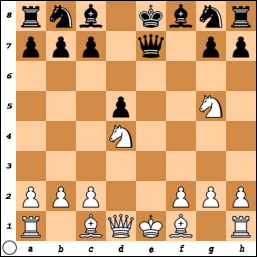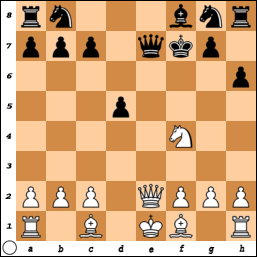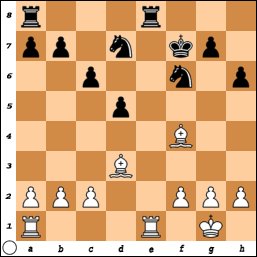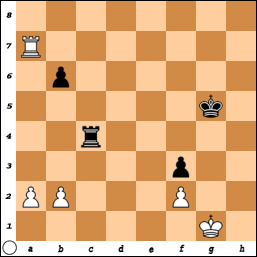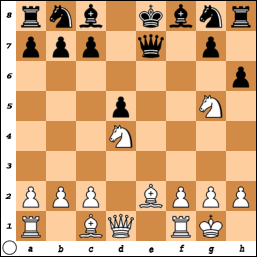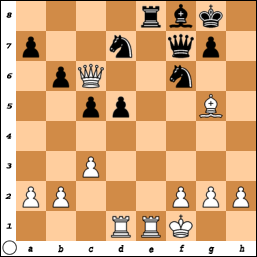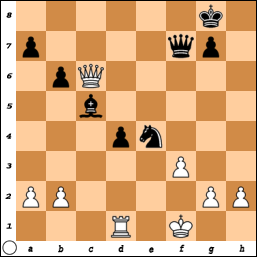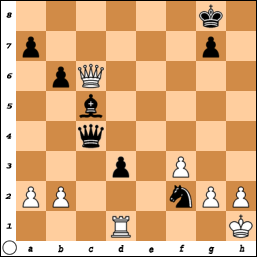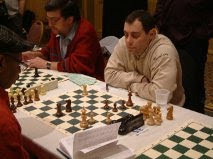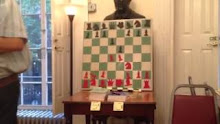Tuesday, December 26, 2006
Philidor Counter Gambit with 6.Neg5
One of the sharpest variations in the Philidor Counter Gambit occurs after the opening moves 1.e4 e5 2.Nf3 d6 3.d4 f5 4.Nc3 fxe4 5.Nxe4 d5 6.Neg5. In his book C.O.O.L. Chess, grandmaster Paul Motwani considers two possible moves for Black: 6...h6 and 6...e4. But recently I have played successfully a third continuation 6...exd4 7.Nxd4 Qe7+.
Game One: Dragan Milovanovic (USCF 2230) - Jim West (USCF 2235), Hamilton Quad 12/17/2005
1.e4 e5 2.Nf3 d6 3.d4 f5 4.Nc3 fxe4 5.Nxe4 d5 6.Neg5 exd4 7.Nxd4 Qe7+ 8.Qe2 h6 9.Nge6 Bxe6 10.Nxe6 Kf7 11.Nf4!?
A better try for White is 11.Nxf8 Qxe2+ 12.Bxe2 Kxf8 13.Bf4 c6 14.O-O Nf6 15.Bd3 Kf7 16.Rfe1 Nbd7 17.Bd6 Rhe8 with the absolute bishop pair, but Black has no pawn weaknesses. In fact, this position is virtually identical to the one arrived at by a different move order 1.e4 e5 2.Nf3 d6 3.d4 f5 4.Nc3 fxe4 5.Ng5 d5 6.dxe5 c6 7.Ncxe4 Qc7 8.Nd6+ Bxd6 9.exd6 Qxd6 10.Bd3 Nf6 11.Qe2+ Qe7 12.Qxe7+ Kxe7 13.O-O h6 14.Re1+ Kf8 15.Ne6+ Bxe6 16.Rxe6 Kf7 17.Re1 Nbd7 18.Bf4 Rhe8, Jerry McDonnell (USCF 2217) - Jim West (USCF 2287), Somerset Quad 2/4/1990.
That game ended in a draw on move 52.
11...Qxe2+ 12.Bxe2 Nf6 13.c4 Bb4+ 14.Bd2 Bxd2+ 15.Kxd2 c6 16.cxd5 cxd5 17.Bf3 Nc6 18.Rhd1 Rhd8 19.Ke1 Ne7 20.Rac1 Rd7 21.h4 g5 22.hxg5 hxg5 23.Nd3 Ng6 24.Nc5 Re7+ 25.Kf1 Rd8 26.Rd4 Ne5 27.Rcd1 Nxf3 28.gxf3 Rh8 29.Kg2 Kg6 30.Nd3 b6 31.Nb4 Nh5 32.Nxd5 Re5 33.Kf1 Nf4 34.Nxf4+ gxf4 35.Re4 Rxe4 36.fxe4 f3 37.Ke1 Kg5 38.Rd7 Re8 39.Rxa7 Rxe4+ 40.Kf1 Rc4 41.Kg1 Rg4+ 42.Kf1 Rd4 43.Kg1 Rg4+ 44.Kf1 Rc4 45.Kg1, draw.
Game Two: Yogesh Raghunathan (USCF 2045) - Jim West (USCF 2200), Empire City Open 12/17/2006
1.e4 e5 2.Nf3 d6 3.d4 f5 4.Nc3 fxe4 5.Nxe4 d5 6.Neg5 exd4 7.Nxd4 Qe7+ 8.Be2 h6 9.O-O
This looks too ambitious. I had expected 9.Ngf3 c6 10.O-O Qf6 11.Re1 Bd6 12.Bd3+ Ne7 13.Bd2 O-O 14.Bc3 Qf7 with chances for both sides.
9...hxg5 10.Bh5+
On 10.Re1 Kd8 11.Bh5 Qxe1+ 12.Qxe1 Rxh5 13.Ne6+ Bxe6 14.Qxe6 Nf6 15.Qf7 Nbd7, Black has more than enough for the queen, or 15.g4 Rh8 16.Bxg5 Nbd7 17.Re1 Bc5 18.Qf7 Kc8 19.Bxf6 Nxf6 20.Qxg7 Rf8 21.Kg2 b6 22.f3 Kb7 with a complicated position. I could have transposed into this line with 10...Kd8 but tried something different.
10...Rxh5!? 11.Qxh5+ Qf7 12.Re1+ Be7 13.Qxg5 Kf8 14.Qe3 Bd7 15.Qb3 b6 16.Nb5 Bxb5 17.Qxb5 c6 18.Qa4 Nf6 19.Be3 c5 20.c3 Nbd7 21.Qc6 Re8 22.Rad1 Kg8 23.Bg5 Bf8 24.Kf1?
I had anticipated 24.Rxe8 Qxe8 25.Bxf6 Nxf6 26.Qxe8 Nxe8 27.Rxd5 Nd6 with a roughly equal position.
24...Ne5 25.Qa4 Ne4 26.Be3 Ng4 27.f3 Nxe3+ 28.Rxe3 Ng3+ 29.Kf2 Rxe3 30.Kxe3 d4+ 31.cxd4 cxd4+ 32.Kf2 Ne4+ 33.Kf1 Bc5 34.Qc6??
My opponent had been behind on time all game long. It finally takes its toll.
34...Qc4+ 35.Kg1 d3+ 36.Kh1 Nf2+, White resigns.
